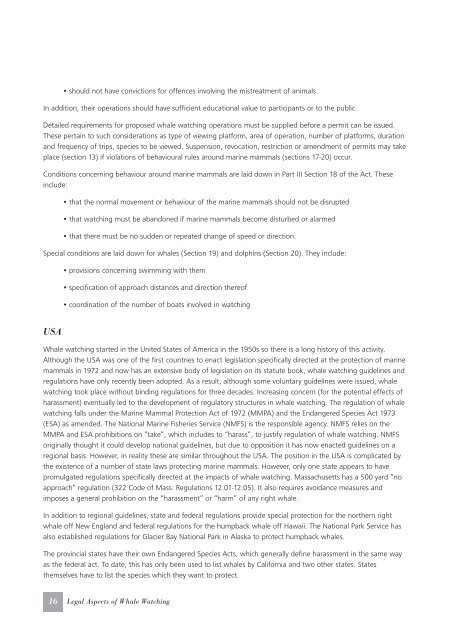leagal aspects of the whale watching.pdf - International Fund for ...
leagal aspects of the whale watching.pdf - International Fund for ...
leagal aspects of the whale watching.pdf - International Fund for ...
Create successful ePaper yourself
Turn your PDF publications into a flip-book with our unique Google optimized e-Paper software.
• should not have convictions <strong>for</strong> <strong>of</strong>fences involving <strong>the</strong> mistreatment <strong>of</strong> animals<br />
In addition, <strong>the</strong>ir operations should have sufficient educational value to participants or to <strong>the</strong> public.<br />
Detailed requirements <strong>for</strong> proposed <strong>whale</strong> <strong>watching</strong> operations must be supplied be<strong>for</strong>e a permit can be issued.<br />
These pertain to such considerations as type <strong>of</strong> viewing plat<strong>for</strong>m, area <strong>of</strong> operation, number <strong>of</strong> plat<strong>for</strong>ms, duration<br />
and frequency <strong>of</strong> trips, species to be viewed. Suspension, revocation, restriction or amendment <strong>of</strong> permits may take<br />
place (section 13) if violations <strong>of</strong> behavioural rules around marine mammals (sections 17-20) occur.<br />
Conditions concerning behaviour around marine mammals are laid down in Part III Section 18 <strong>of</strong> <strong>the</strong> Act. These<br />
include:<br />
• that <strong>the</strong> normal movement or behaviour <strong>of</strong> <strong>the</strong> marine mammals should not be disrupted<br />
• that <strong>watching</strong> must be abandoned if marine mammals become disturbed or alarmed<br />
• that <strong>the</strong>re must be no sudden or repeated change <strong>of</strong> speed or direction.<br />
Special conditions are laid down <strong>for</strong> <strong>whale</strong>s (Section 19) and dolphins (Section 20). They include:<br />
USA<br />
• provisions concerning swimming with <strong>the</strong>m<br />
• specification <strong>of</strong> approach distances and direction <strong>the</strong>re<strong>of</strong><br />
• coordination <strong>of</strong> <strong>the</strong> number <strong>of</strong> boats involved in <strong>watching</strong><br />
Whale <strong>watching</strong> started in <strong>the</strong> United States <strong>of</strong> America in <strong>the</strong> 1950s so <strong>the</strong>re is a long history <strong>of</strong> this activity.<br />
Although <strong>the</strong> USA was one <strong>of</strong> <strong>the</strong> first countries to enact legislation specifically directed at <strong>the</strong> protection <strong>of</strong> marine<br />
mammals in 1972 and now has an extensive body <strong>of</strong> legislation on its statute book, <strong>whale</strong> <strong>watching</strong> guidelines and<br />
regulations have only recently been adopted. As a result, although some voluntary guidelines were issued, <strong>whale</strong><br />
<strong>watching</strong> took place without binding regulations <strong>for</strong> three decades. Increasing concern (<strong>for</strong> <strong>the</strong> potential effects <strong>of</strong><br />
harassment) eventually led to <strong>the</strong> development <strong>of</strong> regulatory structures in <strong>whale</strong> <strong>watching</strong>. The regulation <strong>of</strong> <strong>whale</strong><br />
<strong>watching</strong> falls under <strong>the</strong> Marine Mammal Protection Act <strong>of</strong> 1972 (MMPA) and <strong>the</strong> Endangered Species Act 1973<br />
(ESA) as amended. The National Marine Fisheries Service (NMFS) is <strong>the</strong> responsible agency. NMFS relies on <strong>the</strong><br />
MMPA and ESA prohibitions on “take”, which includes to “harass”, to justify regulation <strong>of</strong> <strong>whale</strong> <strong>watching</strong>. NMFS<br />
originally thought it could develop national guidelines, but due to opposition it has now enacted guidelines on a<br />
regional basis. However, in reality <strong>the</strong>se are similar throughout <strong>the</strong> USA. The position in <strong>the</strong> USA is complicated by<br />
<strong>the</strong> existence <strong>of</strong> a number <strong>of</strong> state laws protecting marine mammals. However, only one state appears to have<br />
promulgated regulations specifically directed at <strong>the</strong> impacts <strong>of</strong> <strong>whale</strong> <strong>watching</strong>. Massachusetts has a 500 yard “no<br />
approach” regulation (322 Code <strong>of</strong> Mass. Regulations 12.01-12.05). It also requires avoidance measures and<br />
imposes a general prohibition on <strong>the</strong> “harassment” or “harm” <strong>of</strong> any right <strong>whale</strong>.<br />
In addition to regional guidelines, state and federal regulations provide special protection <strong>for</strong> <strong>the</strong> nor<strong>the</strong>rn right<br />
<strong>whale</strong> <strong>of</strong>f New England and federal regulations <strong>for</strong> <strong>the</strong> humpback <strong>whale</strong> <strong>of</strong>f Hawaii. The National Park Service has<br />
also established regulations <strong>for</strong> Glacier Bay National Park in Alaska to protect humpback <strong>whale</strong>s.<br />
The provincial states have <strong>the</strong>ir own Endangered Species Acts, which generally define harassment in <strong>the</strong> same way<br />
as <strong>the</strong> federal act. To date, this has only been used to list <strong>whale</strong>s by Cali<strong>for</strong>nia and two o<strong>the</strong>r states. States<br />
<strong>the</strong>mselves have to list <strong>the</strong> species which <strong>the</strong>y want to protect.<br />
16 Legal Aspects <strong>of</strong> Whale Watching
















